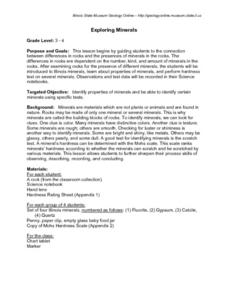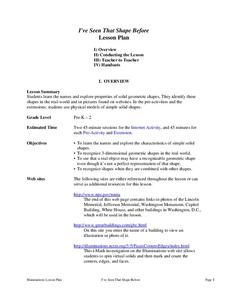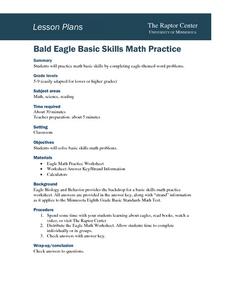Curated OER
Plum Stone Dice Game
Young scholars read about a Native American dice game online. They make replica games, and practice playing with them. They predict the outcome of the dice rolls by completing a dice throw chart.
Curated OER
My Test Book: Ratios, Fractions, and Decimals
In this online interactive math skills worksheet, students solve 10 multiple choice math problems regarding ratios, fractions, and decimals. Students may submit their answers to be scored.
Curated OER
Out and About: The Science of Sport
Students take a closer look at sports science. In this hands-on learning lesson plan, students may visit the Science Museum, the Life Science Centre, or the Wimbledon Lawn Tennis Museum online or in-person to discover details related to...
Curated OER
Exploring Minerals
I love this geology lesson plan. Third and fourth graders look at the connections, and the differences, between rocks and minerals. Learners are charged with identifying specific rocks and minerals, learning how to properly use...
Curated OER
How Old Is Illinois?
High schoolers use fossils found in rocks to determine the age of the strata between Rock Island and Chicago. Pupils pretend they are geologists. They must determine the age of all rock layers between the Mississippi River and Lake...
Curated OER
Virtual Field Trip / Activity Research
Students visit a website to determine activities at three Michigan cities. They calculate the total cost of participating in the activities or visiting places such as zoos, planetariums, historic sites, and museums.
Curated OER
Why Would I Owe My Soul to the Company Store?
Sixth graders listen to "Sixteen Tons" by Tennessee Ernie Ford and discuss what it means to owe one's soul to a store. In this mathematics instructional activity, 6th graders determine what a miner's income was minus his expenses...
Fayetteville Public Schools
I've Seen That Shape Before
The objectives in the resource allow students to explore the characteristics of simple solid shapes. Youngsters learn to recognize the face shapes, corners, and edges that make up 3-D figures by filling in a chart. Lastly,...
Curated OER
The People of Kansas: Where did they come from and why did they come?
Students review census data to correlate to emigration in Kansas. In this Westward Expansion lesson, students analyze a painting and create definitions for emigration and discuss why people emigrate. Students read and analyze 1855 census...
Curated OER
Pi Day
In this Pi Day worksheet, students complete activities such as reading a passage, phrase matching, fill in the blanks, correct words, multiple choice, spelling sequencing, scrambled sentences, asking questions, take a survey, and...
Curated OER
From Future Flight to Past Flight
Students complete a set of CD-ROM's to introduce them to the flight program at NASA. In groups, they research a topic related to flight and put their information on a CD-ROM. To end the instructional activity, they share their material...
Curated OER
Bald Eagle Basic Skills Math Practice
Students solve basic skills math problems involving eagles. They read and discuss facts about eagles and view a video. They complete the Eagle Math worksheet and check their answers. They create additional problems and solve them.
Science Museum, London
Science Museum: Online Stuff: Huygens' Clocks
Find out about Christiaan Huygens who built the world's first pendulum clock in 1656. The pendulum clock became the most accurate clock in the world for nearly 300 years.
Science Museum, London
Science Museum: Online Stuff: Big Clocks
Learn about the development of early clocks from the 14th through to the 19th centuries.
Science Museum, London
Science Museum: Online Stuff: Babbage
Charles Babbage is regarded as the first computer pioneer and originated the concept of a programmable computer. This biography details his accomplishments as a mathematician, philosopher, inventor and mechanical engineer












